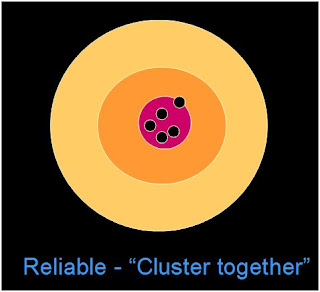You operationalize your variables in order to measure them.
So, now let's talk about measurement and related concepts.
When measuring your variables you may ask yourself...
Is my measure “on target”?
Do my measures “cluster together”?
But what does that mean?
What we are talking about is
validity and
reliability.
Back to measuring prejudice in people. How would you do that? A survey? What would the questions be on the survey? Your measure of prejudice needs to be valid and reliable measures. Are you sure they are valid and reliable?
Validity: “the extent that scales or questions do measure what they are thought to measure”(Stacks & Hocking).
Or think or a bathroom scale. What does it mean to say a bathroom scale is valid or not?

Photo by
elcamino73. Used under Creative Commons.
Reliability: “the extent to which measurement yields numbers (data) are consistent, stable, and dependable.” (Stacks & Hocking).


What about a bathroom scale and reliability? What does it mean to say that a bathroom scale is reliable?

Photo by
elcamino73. Used under Creative Commons.
Can an instrument can be reliable, but not valid. That is, cluster together, but not be on target?
An Example
Let's say we are interested in the topic of
communication apprehension. More specifically, we are interested in the relationship between gender and communication apprehension. Do men or women have higher levels of communication apprehension? How would we go about answering that question?
How would we measure communication apprehension in our subjects (the people we are studying)? We could observe. What about a survey? Yeah, let's do a survey. Something like below.
-------------------------------------
Conversation Apprehension Scale
1. While participating in a conversation with a new acquaintance, I feel very nervous.
Strongly Agree --- Moderately Agree --- Neutral --- Moderately Disagree --- Strongly Disagree
2. I have no fear of speaking up in conversations.
Strongly Agree --- Moderately Agree --- Neutral --- Moderately Disagree --- Strongly Disagree
3. Ordinarily I am very tense and nervous in conversations.
Strongly Agree --- Moderately Agree --- Neutral --- Moderately Disagree --- Strongly Disagree
4. Ordinarily I am very calm and relaxed in conversations.
Strongly Agree --- Moderately Agree --- Neutral --- Moderately Disagree --- Strongly Disagree
------------------------------------
Think of this survey as a measuring instrument, just like a bathroom scale. The bathroom scale measures your weight and this survey would measure your communication apprehension.
Does our instrument (the above survey) have good measurement validity and measurement reliability? How would you determine that?
Measurement validity:
“the extent to which researchers are actually measuring the concepts they intend to measure”(FBFK)
Do the instruments give accurate/true readings?
Measurement reliability:
“the extent to which measurements of a variable are consistent and trustworthy”(FBFK)
Do the instruments continue to give the same readings every time they are used?
What are the procedures for checking an instrument’s reliability?
Similar results every time?
0% = Not reliable to 100% highly reliable
Three Ways to Check Instrument’s Reliability
1. Test and retest it.
2. Test, change wording slightly, retest.
3. Compare 1/2 items to the other 1/2
3 options, Not step-by-step
Which option is best? Costs and benefits?
Share this post with others. See the Twitter, Facebook and other buttons below.
Please follow, add, friend or subscribe to help support this blog.
See more about me at my web site
WilliamHartPhD.com.
























